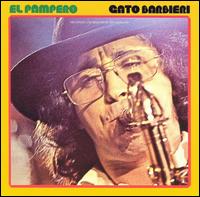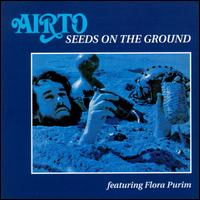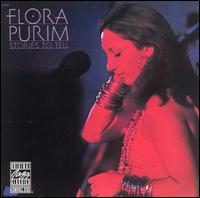(These are excerpts from my book "A History of Jazz Music")
Latin-jazz

Argentinian tenor saxophonist Gato Barbieri relocated to Italy in 1962 and
collaborated with Don Cherry on Complete Communion (1965) and
The Symphony For Improvisers (1966).
Barbieri expanded that experiment on In Search Of Mystery (march 1967), a wild free-jazz session in a quartet with cello, bass and drums, centered around the theme of Michelle and the two movements of Cinematheque, and on the lengthy Obsession (june 1967), recorded by a trio of sax, bass and drums.
After a collaboration with Dollar Brand, Confluence (march 1968),
and a participation to both Mike Mantler's Jazz Composer's Orchestra (1968) and Charlie Haden's Liberation Music Orchestra (1969)
Barbieri
found his mission in life with The Third World (november 1969), that mixed
free jazz and Latin music in a visceral, exuberant manner. Three of the four
compositions paid tribute to great Argentinian composers, and the fourth was
his Antonio Das Mortes.
Barbieri became more interested in offering the USA public jazzy versions of
Latin classics, a less spontaneous but more elegant version of the concept
of Third World, but each album contained at least one Barbieri
composition that also represented his artistic ambitions:
Carnavalito on Fenix (april 1971), featuring Pharoah Sanders' pianist Lonnie Liston Smith guitarist Joe Beck, bassist Ron Carter, drummer Lenny White and Brazilian percussionist Nana Vasconcelos,
El Pampero on the live El Pampero (june 1971),
El Parana on Under Fire (recorded in 1971), featuring Smith, guitarist John Abercrombie bassist Stanley Clarke and percussionist Airto Moreira.
The worldwide success of Barbieri's sensual, melancholy soundtrack for
Bertolucci's Last Tango In Paris (november 1972), released in its entirety only in 1998, stood as a much more personal statement.
Even more emotional was Bolivia (recorded in 1973), by the same players of Under Fire, with Merceditas and Bolivia.
Barbieri's vision of Latin-tinged melodic and rhythmic soundscapes
was fully realized with a tetralogy that employed
larger units and Latin-American musicians:
Latin America (april 1973), his artistic zenith, with Encuentros and the four-part suite La China Leoncia,
Hasta Siempre (april 1973), with Encontros,
Viva Emiliano Zapata (june 1974), accompanied by a big band in four of his short pieces (notably Lluvia Azul),
and the live Alive In New York (1975).
TM, ®, Copyright © 2006 Piero Scaruffi All rights reserved.

After leaving Miles Davis (1970) and Chick Corea (1972), Brazilian percussionist
Airto Moreira
enjoyed a brief moment of notoriety during which he concocted a trivial
world-funk-jazz-soul-rock fusion on albums,
frequently featuring his wife, vocalist Flora Purim,
such as Free (april 1972), that contained his first original composition, the twelve-minute Free, and
Fingers (april 1973), with Tombo in 7/4,
Virgin Land (june 1974).
TM, ®, Copyright © 2006 Piero Scaruffi All rights reserved.

Brazilian vocalist Flora Purim, who had joined Chick Corea's Return to Forever in 1972, was the exotic vocalist par excellence of the decade, although her own albums, such as Butterfly Dreams (december 1973), featuring saxophonist Joe Henderson, keyboardist George Duke, guitarist David Amaro, bassist Stanley Clarke and percussionist (and husband), were vastly inferior to her work with Corea.
TM, ®, Copyright © 2006 Piero Scaruffi All rights reserved.

Classically trained,
Brazilian multi-instrumentalist Egberto Gismonti (guitar, flute, piano), who had already composed the song O Sonho (1968) for a 100-piece orchestra,
fused European classical music, jazz-rock, bossanova and Brazilian choro folk music on
albums such as Sonho 70 (1970), inspired by the movie soundtracks of the 1960s,
Academia De Dancas (1974), with orchestral and electronic arrangements, and especially the suite
Danca Das Cabecas (november 1976) for guitar, piano, flute (all played by Gismonti) and percussion (Nana Vasconcelos). basically bossanova's version of free-jazz improvisation,
Sol Do Meio Dia (november 1977), another venture with Vasconcelos and others (saxophonist Jan Garbarek, percussionist Collin Walcott, guitarist Ralph Towner) into the Brazilian jungle,
and Solo (november 1978), a set of melancholy solos on different instruments, notably the 21-minute Selva Amazonica for guitar.
Despite turning towards new-age music in the 1980s, Gismonti continued to produce profound pieces of music, increasingly classical sounding, such as
Danca Dos Escravos (november 1988), another concept album, this time for guitar only,
Natura Festa Do Interior, off Musica de Sobrevivencia (april 1993),
Mestiso and Caboclo for a Brazilian trio, off Zig Zag (april 1995).
Classical compositions included:
Musica de Sobrevivencia (composed in 1990) for orchestra,
the five-movement cantica Cabinda (composed in 1992) for orchestra,
Strawa no sertao (composed in 1991) for chamber orchestra.
TM, ®, Copyright © 2006 Piero Scaruffi All rights reserved.

Despite being inspired by McCoy Tyner and enlightened by Roland Kirk, pianist Hilton Ruiz opted for an infectious party-oriented fusion of Cuban music and free jazz. After debuting in a trio with the sophisticated meditations of Piano Man (july 1975), Ruiz merged Cuban rhythms and funk music on Rhythm in the House (1976). His danceable zenith was reached with the salsa-infected albums Something Grand (october 1986) and El Camino (october 1987), the latter including the 15-minute Eastern Vibration and featuring Sam Rivers on saxophones.
TM, ®, Copyright © 2006 Piero Scaruffi All rights reserved.

After playing with Gato Barbieri in 1971,
Brazilian-born percussionist Nana Vasconcelos
established his credentials as a virtuoso of the berimbau with Africadeus (1972). While contributing to Jon Hassell's masterpieces, Vasconcelos conceived a fusion of berimbau and symphony orchestra on Saudades (march 1979).
His percussions adorned Don Cherry and Pat Metheny records of the 1980s.
He used voices and the percussive sounds of the human body on Zumbi (1983) and meticulously-tuned drum-machines on Nanatronics (1985), that was never released.
The soundscape of Bush Dance (1986) was crafted by electronic keyboards and Arto Lindsay's atonal guitar.
A more spontaneous, almost childish, form of music surfaced on Asian Journal (1988), recorded by a world quartet of bansuri flute, bass and tablas.
TM, ®, Copyright © 2006 Piero Scaruffi All rights reserved.
Brazilian band Azymuth, formed in 1973 by keyboardist Jose Roberto Bertrami, mixed samba, funk and jazz in dance hits such as Linha do Horizonte (1975) and Jazz Carnival (1978).
Next chapter | Back to the Index
|





